+86 17727759177
inbox@terli.net
- All
- Product Name
- Product Keyword
- Product Model
- Product Summary
- Product Description
- Multi Field Search
Views: 0 Author: Site Editor Publish Time: 2025-08-21 Origin: Site
Yes, solar panels work on cloudy days. While solar panels produce less energy on cloudy days compared to sunny ones, they still generate electricity. Just like you can get a sunburn even when it’s cloudy—because sunlight still reaches your skin—solar panels use both direct and indirect sunlight to make power. The table below shows how much energy solar panels can produce on different types of cloudy days:
| Cloud Condition | Typical Solar Panel Output (% of Sunny Day) |
|---|---|
| Clear, sunny day | 100% |
| Partly cloudy day | 50% to 80% |
| Heavily overcast day | 10% to 25% |
Solar panels on cloudy days still provide clean energy. Even areas that don’t get a lot of sun can benefit from solar panels. Advances in panel technology, smart installation, and energy storage make it possible to generate electricity from solar panels on cloudy days throughout the year.
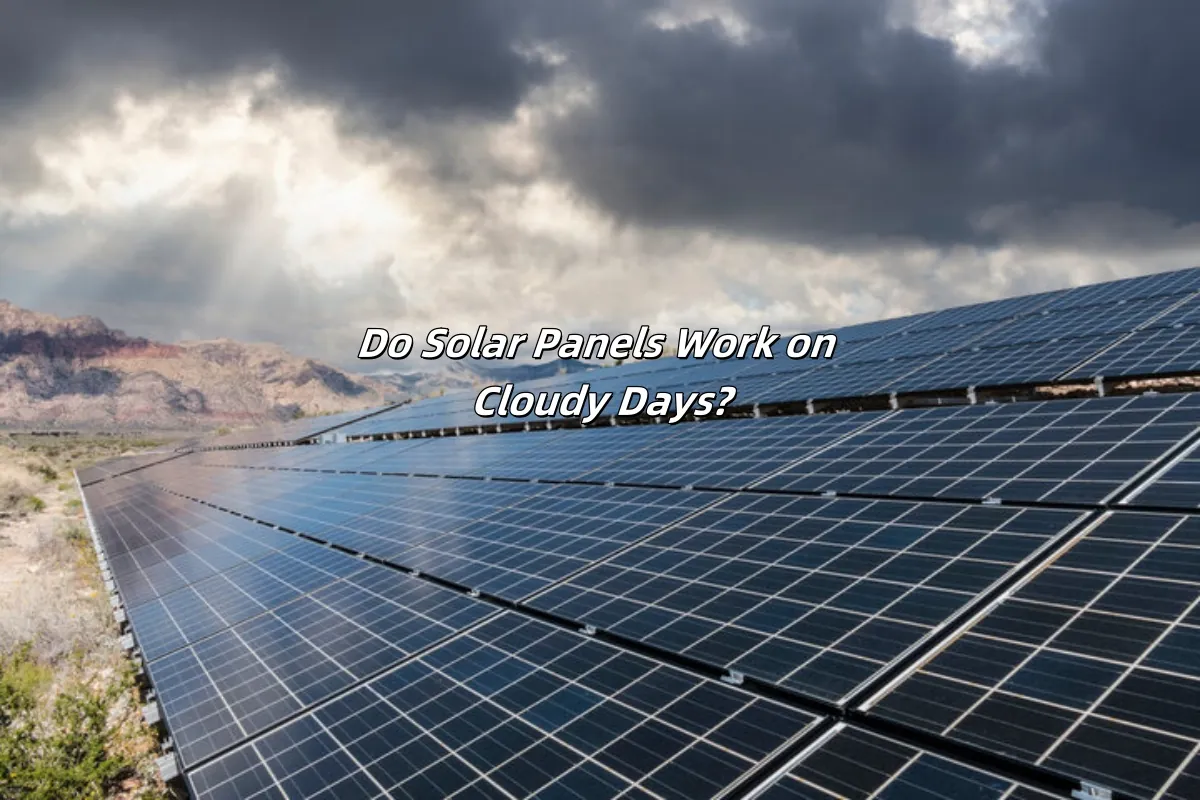
Solar panels make electricity on cloudy days. They use direct and indirect sunlight. They do not make as much power as on sunny days.
Cold weather helps solar panels work better. Electricity moves easier when it is cooler.
Rain washes solar panels and makes them cleaner. This helps them work better by removing dust and dirt. Sticky stuff may need to be cleaned by hand.
Picking the right panel type helps make more energy in low light. Monocrystalline PERC or bifacial panels are good choices. Installing them the right way also helps.
Energy storage systems let you use solar power when there is no sun. Net metering helps keep your home powered all day and night.
You might wonder what happens when the sky is gray. Solar panels use the photovoltaic effect to make electricity. When sunlight hits a solar panel, photons knock electrons loose inside. This movement of electrons creates an electric current. You can use this current to power your home or charge things.
Even on cloudy days, photons still reach the ground. Clouds scatter sunlight, but they do not block it all. This means solar panels work on cloudy days, but with less energy. Think about getting a sunburn on a cloudy day. Some sunlight still gets through. In the same way, solar panels cloudy days still make electricity, even if the sky is overcast.
Tip: Solar panels often work better when it is cool. Cold weather helps electricity move more easily. Your panels may make more energy per photon than on hot days.
Here is a table that shows how the photovoltaic effect helps solar panels work on cloudy days:
| Aspect | Explanation |
|---|---|
| Photovoltaic Effect | Solar panels turn sunlight (direct and indirect) into electricity using the photovoltaic effect. |
| Analogy | Like people get sunburned on cloudy days, solar radiation goes through clouds and makes energy. |
| Efficiency Reduction on Clouds | Solar panels make 10-25% of normal energy during heavy clouds. |
| Rain Impact | Rain washes panels, so they can take in more sunlight and work better after clouds. |
| Cold Weather Effect | Cooler air helps electricity move, so panels work better and make more energy. |
Solar panels work best with direct sunlight, but do not need it to make electricity. On clear days, most energy comes from direct sunlight. On cloudy days, almost all sunlight is indirect. This is because clouds scatter sunlight everywhere.
Solar panels catch photons from both direct and indirect sunlight.
Direct sunlight gives the most energy, but indirect sunlight still lets panels work.
On cloudy days, energy drops to about 10-25% of a sunny day, but panels keep working.
Countries like Germany and the UK use solar panels cloudy days to make a lot of their electricity, even with many gray days.
You can see that solar panels work on cloudy days by using both kinds of sunlight. Even in low light, your panels keep making energy. Newer types, like thin-film and bifacial panels, help panels work better when it is cloudy.
Sometimes, solar panels work even better for a short time when clouds move by. This is called the "edge of cloud effect." When the sun comes out from behind a cloud, sunlight bends and scatters around the edge. This can focus extra light on your solar panels. They can make more electricity than normal for a few moments.
Note: The edge of cloud effect can boost your energy by up to 29% above normal for a short time. This happens because sunlight gets stronger as it goes around the cloud’s edge.
On partly cloudy days, you might see your solar system making more energy than you thought. Cooler air during clouds also helps your panels work better. When the sun comes out, your panels use both the extra light and the cool air.
Solar panels cloudy days show you do not need perfect weather to make electricity. Even when the sky is gray, your panels keep working and catch every bit of energy they can. This makes solar panels a smart choice for anyone who wants clean energy, no matter the weather.
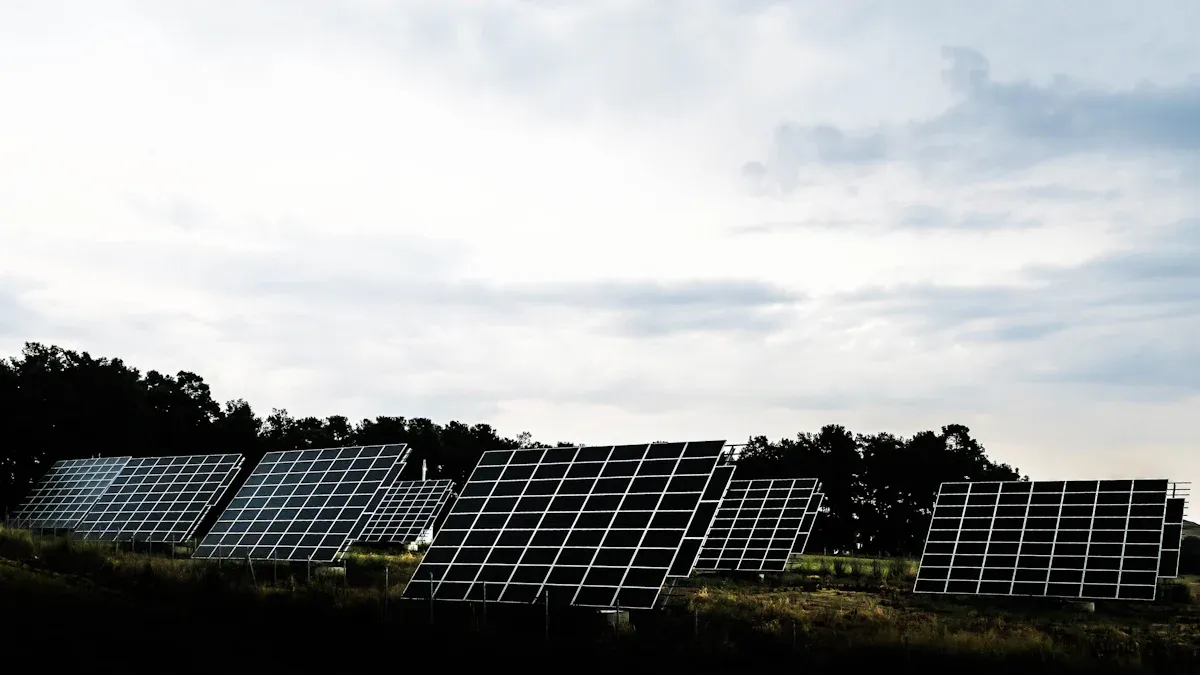
Image Source: unsplash
You might notice that solar panels do not stop working on cloudy and rainy days. Instead, their output drops compared to sunny weather. The amount of sunlight that reaches your panels changes with the thickness of the clouds and the intensity of the rain. On light cloudy days, you can expect your panels to produce about 50% to 76% of their normal output. When heavy clouds or rain cover the sky, output can fall to 10% to 33% of what you get on a clear day.
Here is a table that shows how different weather conditions affect solar panel output:
| Cloud or Rain Condition | Typical Solar Panel Output (% of Maximum) |
|---|---|
| Light Cloud Cover | 50% – 76% |
| Heavy Cloud Cover | 10% – 33% |
| Light Rain | 30% – 50% |
| Heavy Rain | 10% – 25% |
You may wonder why panels still work when the sky looks gray. Even on cloudy and rainy days, some sunlight gets through the clouds. Your panels capture this light and turn it into electricity. Sometimes, on partly cloudy days, you might see a quick boost in energy output. This happens when sunlight bends around the edge of a cloud and focuses more light on your panels for a short time.
Did you know? Even in places with many cloudy days, like Germany or the Pacific Northwest, people use solar panels to power their homes. They rely on the panels’ ability to work in low light and use energy storage to save extra power for later.
Rain does more than just lower the output for a short time. It also helps keep your solar panels clean. Dust, pollen, and dirt can build up on your panels and block sunlight. When rain falls, it washes away most of this loose debris. Clean panels let in more light, which helps maintain high efficiency.
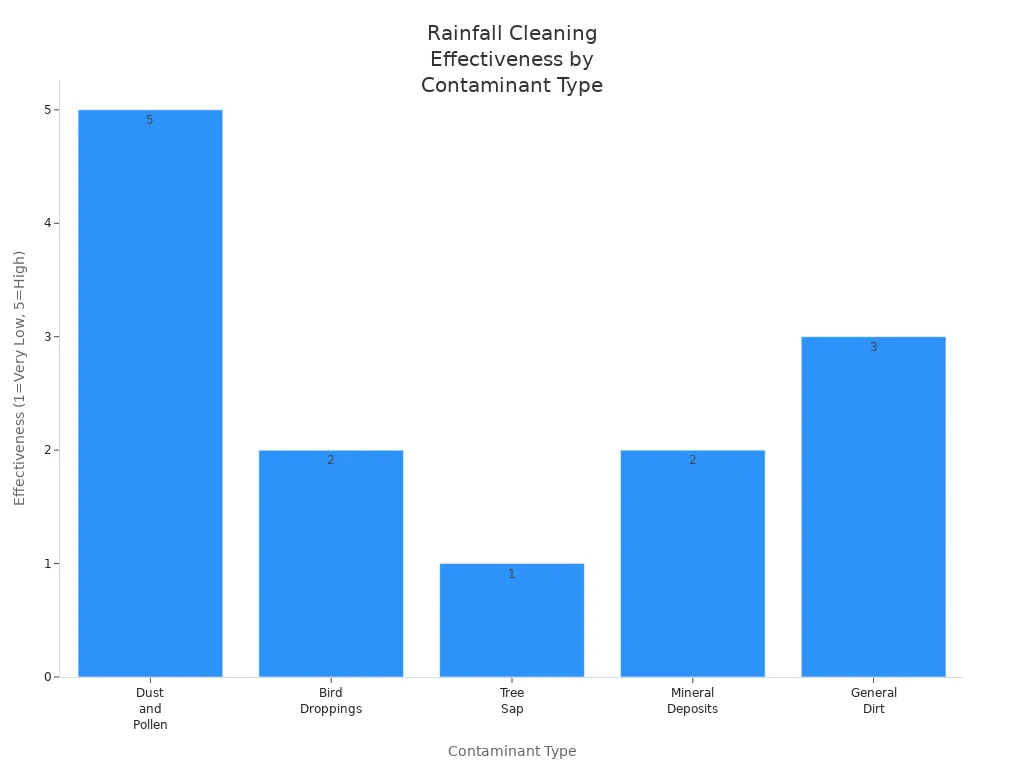
Rain works best for cleaning off dust and pollen. However, sticky stuff like bird droppings or tree sap may need manual cleaning. Here is a table that shows how well rain cleans different types of dirt:
| Contaminant Type | Rainfall Cleaning Effectiveness | Manual Cleaning Required |
|---|---|---|
| Dust and Pollen | High | Rarely |
| Bird Droppings | Low | Yes |
| Tree Sap | Very Low | Yes |
| Mineral Deposits | Low | Yes |
| General Dirt | Moderate | Occasionally |
After a good rain, you might see a boost in energy output. Clean panels can improve efficiency by 5% to 15%. In areas with lots of rain, you may not need to clean your panels as often. Still, you should check them at least twice a year to make sure nothing stubborn is blocking the sunlight.
Think about how you feel cooler on a cloudy day, but you can still get a sunburn. Solar panels work in a similar way. Even when clouds block most of the sun, some rays still reach the ground and your panels. In Kenya, a village used solar panels for irrigation. Even with frequent cloudy and rainy days, the system worked well because the panels could tilt and store extra energy. In India, another village saw less output during the rainy season, but performance improved once the sun returned. In Canada, farmers used special mounts and snow-melting tech to keep their panels working through harsh winters.
Tip: If you live in a place with many cloudy and rainy days, choose panels designed for high efficiency in low light. Add energy storage to save power for times when the sun hides behind clouds.
You can see that solar panels keep working on cloudy and rainy days. Their output drops, but they still provide clean energy. Rain helps keep your panels clean, which boosts efficiency and energy output over time. With the right setup, you can rely on solar power even when the weather is not perfect.
If you want the best solar panels for cloudy days, pick ones that work well in low light. Monocrystalline PERC panels are the top choice. They can reach up to 22% efficiency and still make power when it’s gray outside. Bifacial panels help too. They catch sunlight from both sides, so they use more light that bounces around. This gives you more energy. Thin-film panels do not work as well, but sometimes they do better when it’s cloudy or hot. Hybrid panels are made to store energy instead of just making it.
| Solar Panel Type | Efficiency in Low-Light/Cloudy Conditions | Key Features and Notes |
|---|---|---|
| Monocrystalline PERC | Highest (~20-22%) | Great for cloudy days, less affected by temperature, strong all-day performance |
| Bifacial | ~11% more than standard panels | Uses light from both sides, best for ground or commercial setups |
| Thin-Film | 10-15% | Flexible, lightweight, sometimes better in low light, needs more space |
| Hybrid | Not focused on panel efficiency | Good for storage and grid connection |
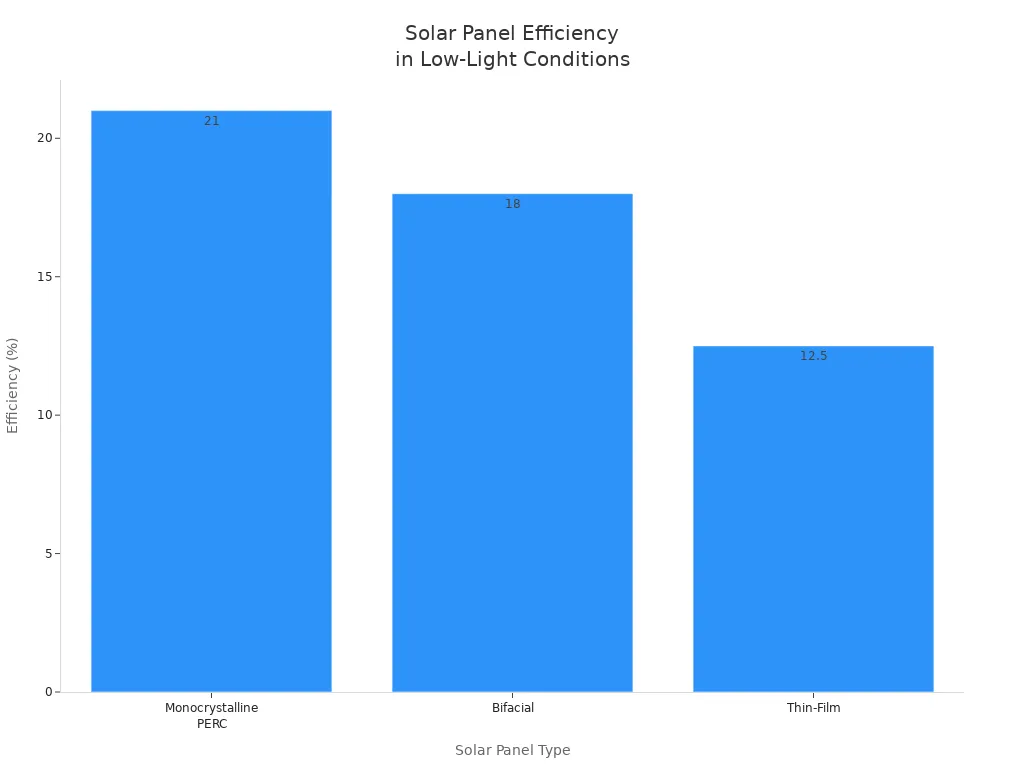
You can make your solar panels work better by pointing them the right way and keeping them clean. If you live in the northern hemisphere, face your panels south. Tilt them between 30° and 45° to catch more light on cloudy days. Try not to let trees or buildings block the sun. Clean your panels often. Even a little dirt can lower how well they work by up to 15%. Check the mounts and wires to make sure everything is safe and working. These steps are even more important when there isn’t much sunlight.
Tip: Clean panels and the right direction help your solar system work better, even when it’s cloudy.
New technology has made solar panels work better in low light. Amorphous silicon cells and CIGS panels do well with scattered sunlight. Bifacial panels use both direct and bounced light, which helps on cloudy days. Anti-reflection coatings and self-cleaning surfaces keep panels clear and working well. Micro-inverters and power optimizers let each panel work by itself, so one shaded panel does not hurt the whole system.
Countries like Germany show how good these new ideas are. Germany has lots of cloudy days, but they are a leader in solar power. This shows that solar panels can work well even when it is not very sunny.
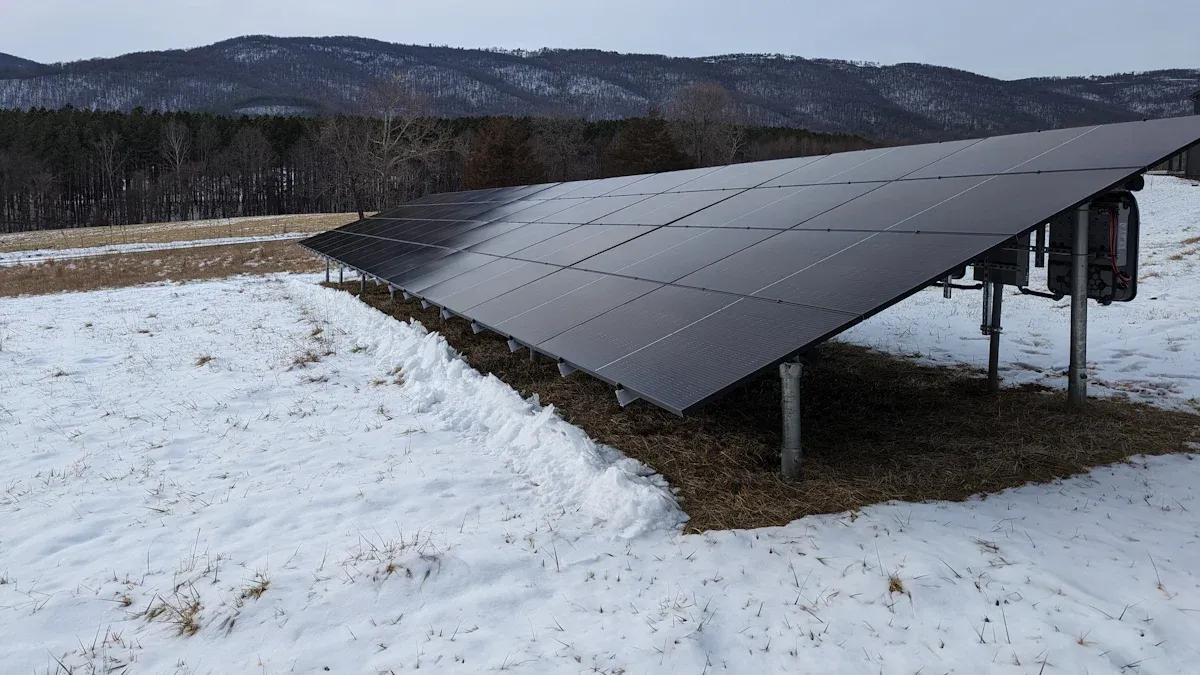
Image Source: unsplash
Some people think solar panels stop in the cold. But cold air can help panels work better. Electricity moves faster when it is cold outside. This means panels can make more power from sunlight. Solar panels need light, not heat, to make electricity. Even in winter, panels work well if the sun is out.
Cold air helps electricity move, so panels work better.
Wind chill makes panels even colder, which helps them more.
Snow on the ground bounces sunlight up to the panels.
Winter days are shorter, so there is less total energy, but each hour is stronger.
Solar panels are made to work in very cold places. They can run in places like Alaska or northern Canada, even with long, cold winters.
Snow and pollution can block sunlight from reaching panels. If snow covers your panels, they stop making energy. Heavy snow can be heavy and push down on panels. Most panels are tilted, so snow slides off fast. Sometimes you need to brush off snow if it piles up.
Dust and pollution also lower how much energy you get. Dust can make panels lose up to 30% of their power. Pollution in the air spreads sunlight, so panels get less light. You can clean panels with water or a soft brush. Cleaning often helps you get more energy from your panels.
| Issue | Impact on Panels | Solution |
|---|---|---|
| Snow Cover | Blocks sunlight, zero output | Tilted installation, manual clearing |
| Heavy Snow | Adds weight, stress | Reinforced frames, prompt removal |
| Dust/Pollution | Reduces light absorption | Regular cleaning, good site choice |
Tip: Bifacial panels can use sunlight that bounces off snow. This gives you more energy in winter.
Solar panels are strong and built to last. They are tested to handle strong wind, heavy snow, and hail. Panels use tough glass and strong frames to stop damage. It is best to have a pro install your panels to keep them safe in storms.
Most panels have two main warranties:
Product warranties cover problems for 10 to 25 years.
Performance warranties promise a certain amount of power for up to 25 years.
Some panels have longer warranties, up to 30 years. Warranties do not always cover big storms like hurricanes. Homeowner’s insurance can help if storms damage your panels. Cleaning and checking your panels helps them last longer and work well.
| Warranty Type | Coverage Period | What’s Covered | Common Exclusions |
|---|---|---|---|
| Product Warranty | 10-25 years | Defects in materials/workmanship | Extreme weather, improper installation |
| Performance Warranty | Up to 25 years | Minimum power output | Neglect, unauthorized repairs |
| Extended Warranty | Up to 30 years | Extra protection | Severe natural disasters |
Note: Always read your warranty and keep your records safe for claims.
Solar panels only make electricity when the sun is out. At night, they stop making power. You can still use solar energy after dark if you have a home battery. During the day, your solar panels run your home and charge the battery. When the sun goes down or clouds cover the sky, the battery gives you stored energy. This keeps your lights and devices working.
Lithium-ion batteries are the most common for home energy storage. These batteries store extra electricity by moving lithium ions when charging. When you need power at night or during an outage, the battery sends stored electricity to your home. Smart battery systems control charging and discharging to keep things safe and efficient. This setup lets you use solar energy even when the sun is not shining.
Tip: Energy storage systems help you keep power during blackouts and use less grid electricity.
Net metering is another way to use solar energy when your panels are not making power. Here’s how it works:
You send extra electricity from your solar panels to the grid during sunny hours.
The utility company gives you energy credits for this extra power.
You use these credits to get electricity from the grid at night or on cloudy days.
Your bill shows the net difference between what you send and what you use.
This system helps you save money and get the most from your solar energy. If you make more energy than you use, your credits can lower your bill or even make it zero.
At night, your solar panels do not work. You still need energy for lights, appliances, and charging devices. With a battery, you use stored solar energy. With net metering, you use energy credits to get power from the grid. Many homes use both systems for the best results.
Solar-plus-storage solutions combine solar panels, batteries, and smart inverters. These systems let you store energy, use it when needed, and help the grid stay stable. Smart inverters talk to the grid and adjust how much energy you use or send back. This makes your home more independent and keeps your energy steady, even when the weather changes.
Note: Solar-plus-storage systems give you more control over your energy use and help you stay ready for any situation.
You can count on solar panels cloudy days to make energy, even if it is gray or rainy outside. Solar panels cloudy days still work by taking in indirect sunlight. Their output can be between 10% and 60%. Energy storage and net metering help you use extra energy when there is not much sun. People who live in places with less sun can still get good results with new panels and smart planning.
Pick the best panel type and face it the right way
Add storage to keep energy steady
Clean your panels often for better performance
| Key Step | Benefit |
|---|---|
| Check your energy needs | Get the right size system |
| Talk to experts | Make your system work better |
| Use special offers | Save money |
Look for solar choices that match your weather and how much energy you need.
You get energy from solar panels in winter. Cold air helps panels work better. Shorter days mean less total energy, but panels still make electricity when the sun shines.
Rain does not harm your solar panels. It helps clean off dust and dirt. You should check for heavy debris after storms to keep panels working well.
You should clean your panels two times each year. Rain helps remove loose dirt. If you see bird droppings or sticky spots, clean them sooner for best results.
Snow blocks sunlight, so panels stop making energy. Most snow slides off tilted panels. You can brush off heavy snow to help panels work again.
You benefit from solar panels even in cloudy places. Modern panels work well with indirect sunlight. Many people in Germany and the UK use solar power every day.